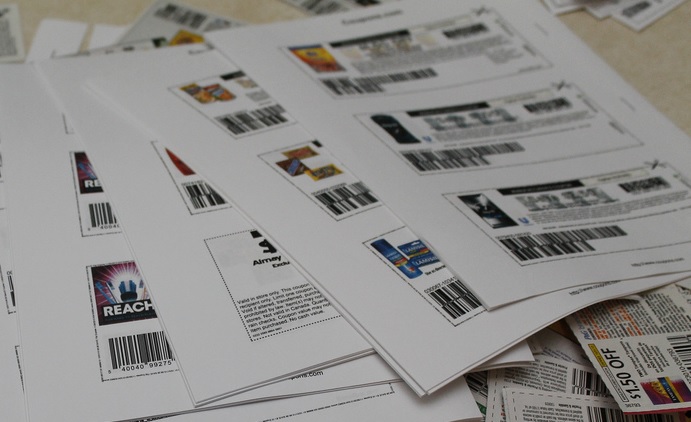
The rise of digital paperless coupons isn’t making much of a dent in newspaper insert coupons’ continued dominance. But it’s sure having an effect on printable coupons. Printables may not be gone just yet, but they continue to fall out of favor – so much so, that for the first time, they now represent a minority of the coupons clipped by users of Coupons.com, the company that built an entire business on allowing you to print your own coupons at home.
It’s a long-expected, but significant, tipping point. Now that the largest printable coupon provider has seen digital coupons overtake its legacy printables, it may only be a matter of time before digital pushes out printables for good – just as Coupons.com has predicted, and would actually prefer.
Coupons.com parent company Quotient Technology now reports that paperless coupons represented more than half of the coupon transactions it recorded in 2015, pushing printable coupons to secondary status. As recently as the end of 2014, print transactions were still more plentiful than paperless. But the two reached parity and stayed there for most of 2015, until paperless soared by 31% at the end of the year, while print essentially flatlined.
For a company that helped pioneer printable coupons, the shift away from paper might seem like a worrying development. Instead, the shift has Quotient optimistic about its future, as it sharpens its focus on mobile and digital. “As the digital evolution continues, and our mobile traffic increases, we believe it will provide a tailwind to our long-term growth,” Quotient CEO Steven Boal told investors.
And those comments come a year after Boal declared that “we’d love to see consumers go completely paperless.”
The continuing gravitation toward digital coupons is in line with what Inmar found in its most recent annual Promotion Industry Analysis. 46% of the consumers surveyed agreed with the statement, “I wish all coupons were digital,” up from 37% who said so in 2013.
The hard numbers also bear out digital coupons’ growing popularity. Printable coupons, Inmar found, represented just 3.2% of all coupons redeemed in 2015, down slightly from 2014 and way down from their recent peak of 5% in 2013. Digital paperless coupons’ share was slightly smaller, but they’re catching up fast. Paperless load-to-card coupons made up 2.5% of all coupons redeemed last year, nearly double the percentage of the previous year, and way up from a negligable fraction of a fraction of a percent back in 2010.
When it comes to the total number of coupons actually available, insert coupons still dominate, with 89.1% of the total share. So they’re not going anywhere, any time soon. But printables’ share is declining, while paperless is rising, with the two presently in a dead heat. For the second year in a row, the two each made up 0.3% of all coupons distributed. If paperless pulls ahead of printables this year, it will confirm a 2014 study’s prediction that the number of digital coupons will surpass printables by 2019 – beating that target date by three years.
Despite its professed desire to go entirely paperless, Coupons.com hasn’t completely given up on printables just yet. Over the past year, it’s introduced a new and improved print solution for desktops, and made it easier to print coupons from a mobile device. In fact, by the end of last year, 5% of all coupon prints from Coupons.com were initiated on mobile devices.
And yet, those innovations only led to a 1% increase in the total number of coupons printed at the end of last year. So making coupons easier to print is not necessarily resuscitating printables, so much as it is delaying what appears inevitable, by propping up a fading platform until digital takes over for good.
Mobile users now represent about 35% of the traffic on Quotient’s properties, up from less than 20% this time last year. And that percentage, too, is expected to rise, to the company’s delight. “We actually view mobile as a really positive transformation for our business,” Boal said. “The higher the use of mobile, the more frequently people are going to engage.”
Many longtime coupon users grumble about digital coupons, complaining that they can only be used once, they don’t double, they can’t be combined with other coupons, and they aren’t always correctly applied to their purchases. So they tend to view the rise of digital with suspicion – seeing it as the work of retailers and consumer packaged goods companies (CPGs) forcing the technology on an unwilling populace.
But Quotient contends it’s quite the opposite – it’s coupon users who are leading the charge. “Consumers are bringing retailers and CPGs into the digital era at an accelerated pace,” Boal said.
So the industry may have been slow to adapt to digital coupons, and veteran couponers may be slow to embrace them. But to members of a new generation who don’t even own a printer, printable coupons may someday be as old-fashioned as their grandmothers who used to use them.
Whether you’re a digital coupon fan or not, it seems the future is upon us – ready or not.











CI supports the shift away from internet printable coupons, despite having pioneered the space, because they are rational actors.
PAH coupons aren’t really profitable for CI – too much rev share on discovery, and no control over redemption.
CI offers a closed digital coupon platform (Retailer iQ) that allows them to keep every nickel & byte of data… without pesky clearinghouses & external audits to make sure everything’s kosher. (Trust us!)
Of course Mr. Boal would like to see all coupon users go digital. To Retailer iQ, specifically. Because Coupons.com would like to turn a profit, at some point, once, ever, in its existence.
Actually, the opposite is true. Quotient has to share 100% of paperless revenue with the retailers whose frequent shopper ID’s are where the coupon gets “clipped”. And the price per coupon clipped is about $.05/per, vs. approximately $.08/per for PAH coupons. And because the vast majority of PAH coupons are printed directly from coupons.com vs. from a retailer’s website, no rev share is required. Boal has no choice but to go paperless, as thi is where the brands, retailers, and consumers are going. He will need to figure out how to please Wall St. with a rev model that is radically less attractive than his legacy PAH model.
Good point, but you’re only looking at rev share on the back end with the retailer (where RiQ is installed). CI doesn’t have to share discovery (the clip fees you note, which are a bit low btw) with the downstream publishers who send traffic back to CI via affiliate and other channels. (again, not the retailer rev share piece)
And CI still keeps ALL the redemption data & analytics, which in the long run is WAY more valuable than any discovery peanuts or redemption shekels.
But you’re right – Boal has no choice to go paperless. I just hope this industry doesn’t get dominated by an 800lb gorilla who sells back data & insights without having to disclose their methodology or be externally audited.
Good talk.
I suspect Quotient invented this report to suit its own purposes. My own experience is the opposite – I use far more printable coupons than insert or digital. What’s not to like about them – you can print more than one and some stores double.